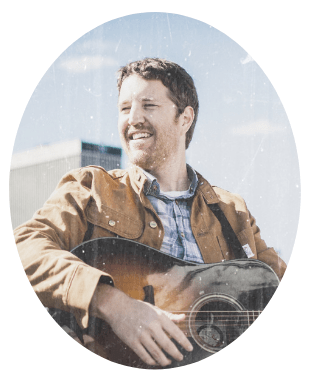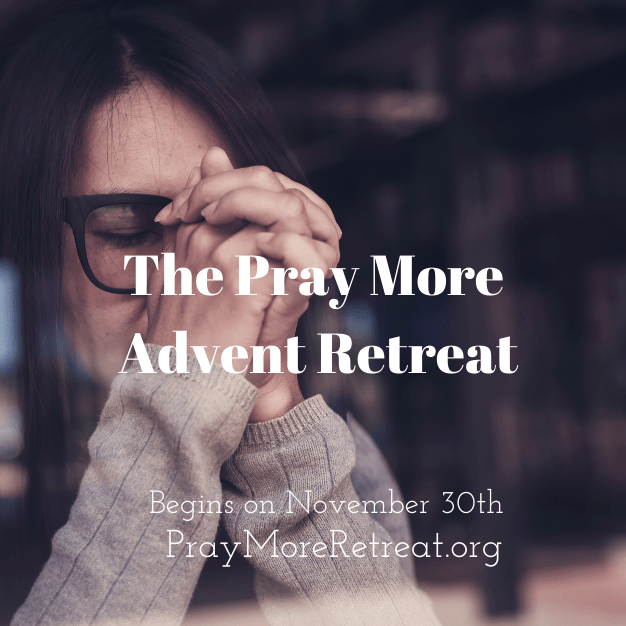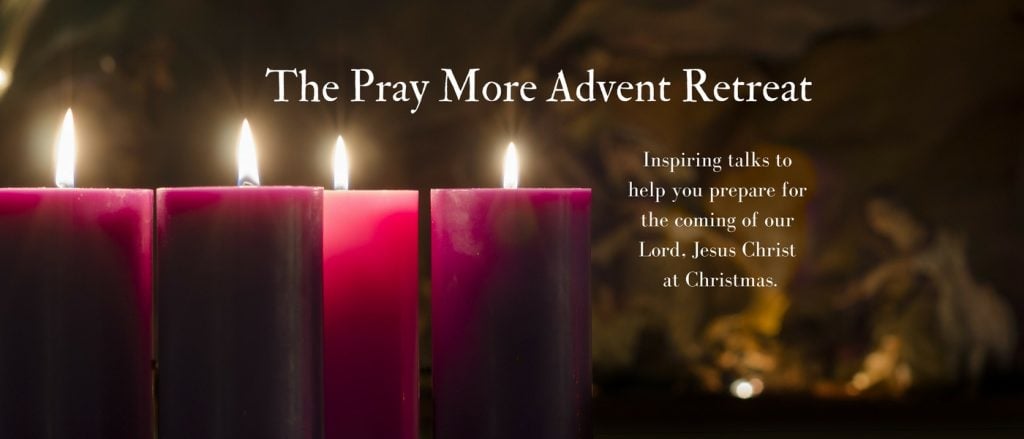Summary
In this talk, Kevin Heider guides us through his meditations and reflections on a painting of the nativity scene by Geertgen Tot Sint Jans. He shares his insights and inspiration from the painting and reminds us of the importance of preparing for Christ’s coming.
Thank you for watching and participating in this retreat!
Not Registered, yet? Don’t miss the rest of the talks! Register for the Pray More Retreat!
Downloads
Audio MP3
Click here to download audio file.
Printable Transcript PDF
Click here to download the transcript of the video presentation.
Text: O Light That Knew No Dawn
Hi, my name is Kevin Heider. I am a singer/songwriter, performer, recording artist. I also work with video and graphic design. I have a podcast. I like the arts. I enjoy all things creative and I’m a storyteller at heart. If you’ve watched any of my presentations in the last few Pray More Online Retreats, then you kind of know what to expect here. In just a moment, I am going to disappear and for the rest of this video, we will be looking at and reflecting on a work of art because I found that sitting with works of sacred art and meditating on them is such a unique and profound way to encounter God, to contemplate what is true and what is good by basking in something beautiful.
The painting that I’ve chosen for this Advent reflection is a work of oil on oak panel from the Netherlands. It was painted in the year 1490 by the hand of the young Geertgen Tot Sint Jans. I have no idea if I am pronouncing his name correctly. Regardless, let’s take a moment and prepare to kind of prayerfully enter into this work of art.
The Primary Source of Light
This work depicts and is so titled “Nativity at Night.” I can’t quite say what it was that drew me to this painting in the first place. There was just something about it. From the moment I saw it, I liked it. It’s calm, it’s peaceful, it’s simple. The most obvious first place to start our reflection I think is on the light. The infant Jesus, laying in the manger is the primary source of light in this painting. They’re faint, but you can see the holy rays emanating from him. It is Christ’s light that is illuminating the faces of Mary and the angels around him. And this is actually a fairly common visual theme in paintings depicting the Nativity. Christ is the light by which we see all others.
I like this one a lot because he’s so snugly and sweetly wrapped in swaddling clothes, sleeping in heavenly peace and there is nothing more precious or profound than being in the presence of a newborn in this state. But I digress. Perhaps you’ve noticed this visual theme before in Nativity paintings. Well, there’s actually a source for this symbolism. In the revelations of St. Bridget of Sweden, a 14th century mystic, a vision of the Nativity scene is described thus. “Verily, though all of a sudden I saw the glorious infant lying on the ground naked and shining. Then I heard also the singing of the angels, which was of miraculous sweetness and great beauty. When therefore, the Virgin felt that she had already born her child, she immediately worshiped him, her head bent down and her hands clasped with great honor and reverence and said to him, “Be welcome, my God, my Lord and my son.”
It’s kind of uncanny, isn’t it? The infant lying on the ground naked and shining, the angels, Mary’s head bent down, and hands clasped with great honor and reverence. Many believe that this artistic troupe that emerged in the Renaissance was directly inspired by this mystical vision of St. Bridget of Sweden. It seems to me that I became such a common image that it persists even today in more contemporary depictions.
Silent Night
I’m immediately reminded of the third verse of “Stille Nacht” or “Silent Night.” The lyrics to this beloved carol were penned in 1816 by Father Joseph Mohr, an Austrian Priest. As you may well recall, the third verse of the hymn goes: silent night, holy night, son of God, love’s pure light, radiant beams from thy holy face with the dawn of redeeming grace. Jesus, Lord at thy birth. A saint’s mystical vision, a painter’s brush on an oak panel, a priest’s Christmas poem, each bears its own artistic witness to Christ, the light of the world sent down into darkness.
Appearance of Simplicity
At first glance, this depiction of the Nativity seems simple, almost like it’s the polar opposite of so much of what came from the Renaissance and the Baroque periods. With the central panel in van der Weyden’s gorgeously detailed “Triptych,” Matthias Grunewald’s gloriously stunning “Concert of the Angels and Nativity,” the simple beauty of Gerard van Honthorst’s “Adoration of the Shepherds,” I would argue, I will argue here now that Geertgen’s “Nativity at Night” stands out not because of its simplicity per se but because of its appearance of simplicity. To me, this piece has the unique feel of an icon at first glance and then of a literary painting upon closer inspection.
There is so much to contemplate in this painting. There’s so much more going on than what we’re initially naturally drawn to. Because of the chiaroscuro, the strong visual contrast between light and dark, our attention is naturally drawn to Mary and the Christ child laying in the manger. As with an icon, the observer feels invited in to an experience with this young mother and her newborn son. But in a moment, another burst of light catches the eye, a distraction in the upper left corner of the painting. What is that strange clump of light and those silhouetted figures on a hill in the distance? Shepherds, warming themselves by a fire out in the fields keeping watch over their flock by night when lo, an angel of the Lord appeared to them and the glory of the Lord shown around them and they were struck with great fear and the angel said unto them, “Fear not for behold, I bring you good tidings of great joy, which shall be for all people for today, in the City of David, a Savior has been born for you who is Messiah and Lord.” It’s right there.
Seeing What’s in the Shadows
The artist’s hand is encouraging us it seems to simply sit with this mother and child and bask in their love, but the same hand also leaves us with so many more morsels to chew on. As our eyes move back slowly from the angel and the shepherds, as we move through the doorway, we get a better sense of the setting, of the humble stable that the God of the universe has humbled himself to be born into.
Here, I’ll turn up the brightness so we can see more of what’s in the shadows. It almost looks as though this brick wall was never finished or has fallen into disrepair. It looks either incomplete or crumbling. Likewise, the wood paneling on the eave above the door, it remains either incomplete or damaged. Such impoverished conditions, this is by no means an ideal place to deliver a baby.
Inspiration from Bono
It reminds me of a beautiful reflection I once heard from Bono, yes, Bono, the founder and front man of the Irish rock band U2. I’m a big fan. As the story goes, several years ago on Christmas Eve, Bono found himself at St. Patrick’s Cathedral in Dublin, stuck behind a large pillar that obstructed his view of the altar. Distracted by the obstruction, his mind began to wander, and he had this thought. “The idea that God, if there is a force of logic and love in the universe, that it would seek to explain itself is amazing enough. That it would seek to explain itself and describe itself by becoming a child born in straw poverty, in excrement and straw, a child. I just thought wow, just the poetry, unknowable love, unknowable power describes itself as the most vulnerable. There it was. I was sitting there and it’s not that it hadn’t struck me before, but tears came streaming down my face and I saw the genius of this. Utter genius of picking a particular point in time and deciding to turn on this.”
Seeking Inspiration From Saint Joseph
The word was made flesh and dwelt among us in a dilapidated stable, away in a manger, no crib for a bed because the hearts of men are full enough of other things. We might as well let God sleep in a drafty barn on the outskirts of town. And imagine as the husband, the earthly father, the provider and protector of the family, how St. Joseph must have felt about this. This, for my family, a stable? How has it come to this? How could this be anyone’s plan? How am I ever going to give this woman and this child what they deserve when I can’t do better than this now? Oh God, please help. And there he is. Joseph waiting patiently, humbly in the background. Whatever doubts, fears, insecurities and unbelief he may have felt prior to the birth, how they must have melted, at least for one holy night. The look on his face here, it’s full of a peaceful wonder, reverence and awe as his hand clutches his heart, as he wonders whether he’ll ever be able to remotely understand or experience the love between this mother and her son.
Of course, he wants to get a closer look with the angels and the animals but not yet. Mom needs some time first. She’s gone through so much to get him here safely. St. Joseph, foster father of our Lord Jesus Christ, true spouse of the Virgin Mary, pray for us and those in agony today. And from one undeserving and imperfect father to another, thank you for your service.
Christmas All Year Round
Now, as I prepare to offer one final note of reflection here, I want to share a brief story. It should illustrate to you just how much I genuinely love Christmas and love talking about Christmas. I am a Christmas fiend. You may have a weird friend who listens to Christmas music year-round. I am that weird friend. I remember one instance in college, it was my sophomore year, early October. I’m in my dorm room, the door is open and Christmas music is playing on my stereo. I see this guy who lives on the lower floor of the dorm. We don’t really know each other but we’ve seen each other around. He walks past my room, stops, comes back, steps into my doorway and says, “Hey, why do you always have Christmas music playing? You know it’s October, right?” With a smile on my face and a consciously cliche answer that I’d given dozens of times before, I said to him, “You know, I listen to Christmas music year-round because Christmas is the most wonderful time of the year and I think every day should be like Christmas.” And normally when I say things like that, Grinches just roll their eyes. But he kind of chuckled and said, “Well, I have to say, every time I walk past your room, my spirit is lifted.” And then he walked away. I don’t think I ever knew his name, but this memory has stayed with me as a happy affirmation of the joyful spirit of Christmas.
Ever since I was a kid, I’ve loved Christmas and everything about the season. But it wasn’t until I got older and began seeing the world and the words of scripture and the faith of my father’s through the lens of poetry and of art that I started to understand why. That the poetry of Christmas that Bono realized later in his life, that the gravity of the incarnation took on a deeper meaning that only enhanced the wonder I’d always had. Yes, of course, I realize this is the Pray More Advent Retreat and I’m not trying to jump the gun to Christmas here, but the point of Advent is to prepare for an arrival, the arrival of what? Of whom? The arrival of the light that knew no dawn into history’s holiest night. The arrival of light from light made flesh to dwell among us and to illuminate the narrow way through a world of darkness, disease, war, imperialism and greed.
The Incarnation
Chiaroscuro, that strong contrast between light and dark used by so many of history’s most gifted and accomplished artists, it’s not just a style or technique of painting, it’s practically built into the living traditions of the church. Every week during Advent, we light another candle on the wreath, which means that every week, the light grows, and the darkness diminishes. As Catholics, we profess the Creed every Sunday at mass. For us men and for our salvation, he came down from heaven and then, we bow together and continue and by the Holy Spirit was incarnate of the Virgin Mary and became man. That’s the incarnation. That one line of the Creed for which the church asks us to bow together in unity is Christmas. Every Sunday, we bow for Christmas. Every time we sing the Gloria at mass, even in July, we’re singing together the words that the angels sang to the shepherds at Christmas. It’s all right there. It always has been.
A Wood Inextricably Linked
The mystery of Christmas, of humanity’s first look at the incarnation of a child born to die. As the Eucharist is the source and summit of the faith, the incarnation is the central event of human history. There is no resurrection, there is no rebirth without death and there is no death without that first birth. The wood of the manger and the wood of the cross are inextricably linked.
Bono had his moment of poetic revelation while stuck behind a pillar on Christmas Eve. I had my moment while contemplating Christmas while walking across my college campus in flip flops on a sunny spring day. The very same body of Christ hung on the cross and was laid in a manger, moments after birth. And what is a manger? A manger is a feeding trough for animals. So, from the moment he’s born, Christ is laid down as food for God’s creation. What child is this? Why lies he in such a mean a state where ox and ass are feeding? There they are, right between the mother of God and the angels. And the ox and the ass, themselves in adoration of the Christ child whose radiant light illuminates them. Behold, behold, the wood of the trough in which is laid our salvation. Oh come, let us adore him.
The First Eucharistic Adoration
In Arabic, Bethlehem means house of meat. In Hebrew, Bethlehem means house of bread. The Eucharist is prefigured at the first Christmas. It’s the same body of the same Christ and when the magi, those three wise men from the East later entered the house and prostrated themselves to do him homage, that was the first Eucharistic adoration. It’s the same body of Christ.
Closing Prayer
It is always a joy for me to get to share my love of this season with others. I hope you’ve enjoyed and appreciated it and that these thoughts have moved you as they’ve moved me over the years. As I wish you a blessed Advent and a merry Christmas, I invite you to sit with this beautiful image for another moment and to pray with me the words of a fourth century hymn by St. Gregory of Nazianzus.
O Light that knew no dawn, that shines to endless day, all things in Earth and heaven are lustered by thy ray; no eye can to thy throne ascend, nor mind thy brightness comprehend. In supplication meek to thee I bend the knee; O Christ, when though shalt come, in love, remember me, and in thy kingdom, by thy grace, grant me a humble servant’s place. Thy grace, O Father, give, I humbly thee implore, and let they mercy bless thy servant more and more. All grace and glory be to thee, from age to age eternally. Come, O come Emmanuel, O light that knew no dawn. In the name of the Father and of the Son and of the Holy Spirit. Amen.
About Kevin Heider

Kevin Heider is a singer-songwriter, performer, and recording artist from Dayton, Ohio. Having written hymns, drinking songs, and everything in between, his music is imbued with a spiritual and social consciousness that explores what it means to be human.
In July of 2008, Kevin was personally selected by Ingrid Michaelson as the winner of Gibson’s The Way I Am contest. This inspired him to pursue a life in the arts, and he has since traveled and toured extensively with his music. He performs solo and with his full band, The Honest Stand.
Kevin is also the creator and host of the popular Song & Story podcast. His music is available everywhere digitally, and physical copies can be purchased at KevinHeider.com

